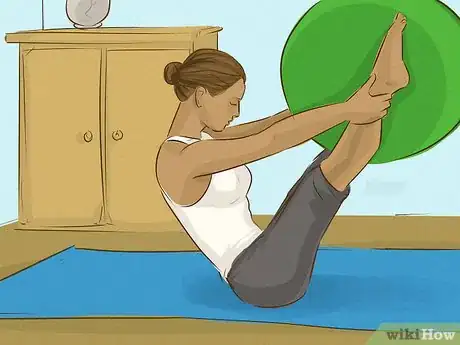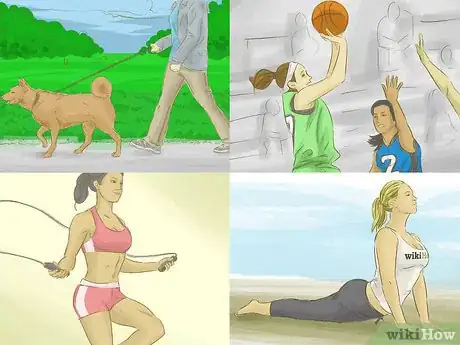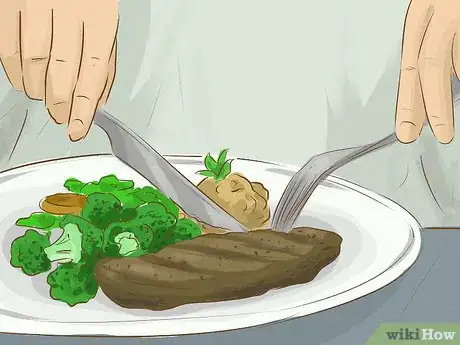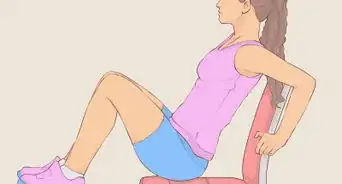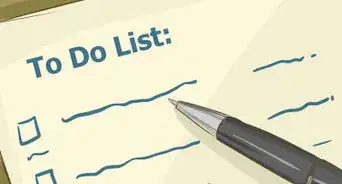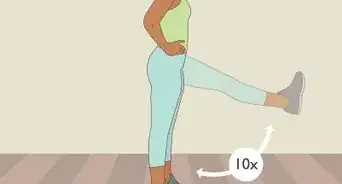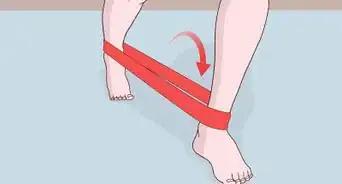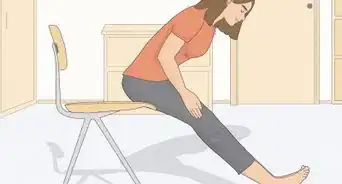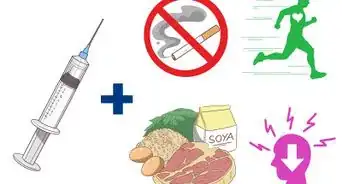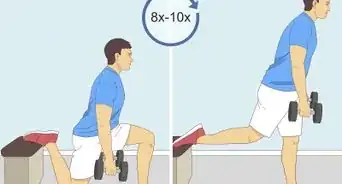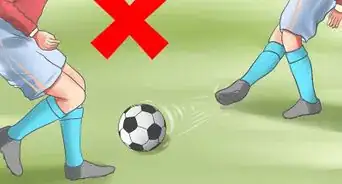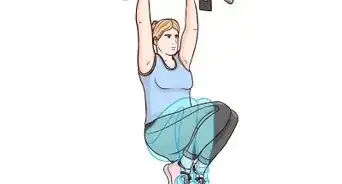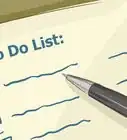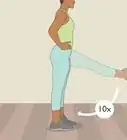This article was co-authored by Pete Cerqua. Pete Cerqua is a Certified Personal Trainer and Nutritionist. Pete is also a five-time best-selling author of books including "The 90-Second Fitness Solution" and "High Intensity Fitness Revolution for Women/Men" published by Simon and Schuster and Skyhorse Publishing. Pete has over 20 years of personal training and nutrition coaching experience and operates the 90-Second Fitness flagship studio in New York City.
wikiHow marks an article as reader-approved once it receives enough positive feedback. In this case, 96% of readers who voted found the article helpful, earning it our reader-approved status.
This article has been viewed 279,231 times.
Lower body strength helps us in many ways, from walking to running to building endurance. The primary muscles in the lower body that you should focus on to build your lower body strength are the gluteals (in the lower back and outer hips), quadriceps (in the front of the thigh), hamstrings (in the back of the thigh), adductors (in the inner thigh), and the calf and shin muscles. In order to strengthen these muscles, you’ll need to do a number of exercises.
Steps
Using Weights or Weight Machines
-
1Do leg extensions to work your quadriceps. The quadriceps are the muscles in the front of your thigh. They are important to the function of your knees. Leg extensions will help build your quadriceps, but you need to be careful not to put too much strain on your knees or shins.
- Sit on the machine and place your legs behind the bar. The bar should rest against the front of your ankles. Slowly push outward against the weight until you fully extend your legs in front of you. Do not extend into a straight leg; at the height of the movement, keep your knee slightly bent. Slowly lower to the starting position. Repeat 8 to 12 times per set.
- Try starting out with no weight until you are used to the movement. Slowly add weight in five pound increments, until you have found a weight that is doable but challenging.
-
2Perform hamstring curls. The hamstrings are the muscles in the back of your thigh. They are extremely important for walking and running. Be sure to warm-up before doing hamstring exercises. Because hamstrings work with your quads and glutes, it is important that you safely work out all of these groups to prevent injury.
- To do hamstring curls, lie on your stomach with your legs straight. Lift one foot by bending the knee. Bring it towards your butt while keeping your thighs against the floor. You can increase the difficulty of this move by wearing a weighted ankle cuff. Repeat 8 to 12 times for two to four sets.
- You can use a machine for this move. Locate and position yourself on a supine machine, with your legs extended behind you. Place your ankles under the bar. Slowly push against the bar to raise it toward the ceiling until your legs curl at more than a 90-degree angle. Lower your legs and the bar back to the starting position. Repeat 8 to 12 times for two to four sets.
- When doing this move, keep your hips pressing down onto bench or mat. Do not hyper extend the lower back, but do keep calf muscles relaxed to isolate the hamstrings. Contract your abs throughout the movement.
Advertisement -
3Do single-calf raises with dumbbells. Calf muscles are important for mobility and running. They help protect your ankle and ensure that your knees functions properly. Be aware that putting too much strain on the calf muscle can cause injury. Do not use too much weight or do too many reps when working on your calves.[1]
- Stand on the edge of a platform with a dumbbell in either hand. Your toes and balls of your feet should be on the platform while your heel and arches should be off the edge. Raise one heel up behind you.
- Slowly rise up on your toes and back down. Do twelve to fifteen reps before switching to the other foot. Do two to four sets overall.[2]
-
4Enhance your thigh muscles with resistance bands. Tie a resistance band around your ankles. Stand so that you can steady yourself against a stationary object – like a wall or door post – and so you have room to move your feet from side to side. To work the outer thigh, keep one leg immobile and push your other foot out to your side so that your leg is working against the resistance of the band.
- You will need to do this 8 to 12 times for each muscle on each leg.
-
5Squeeze a swiss ball to strengthen your inner thighs. Lie down on a mat. Lift your legs so that they are bent at the knee, and place a swiss ball between your thighs and knees. Squeeze your legs together as hard as you can for two seconds, and release. Repeat eight to twelve times.
Strengthening With Resistance From Your Own Body
-
1Use your body weight to work your calf muscles. Stand on an elevated surface with the balls of your feet firmly positioned on the platform and your heels hanging off the edge. Push your body up and then back down to your starting position.[3]
- Repeat 8 to 12 times.
-
2Perfect the lunge to strengthen your gluteus maximus, hamstrings, and quadriceps. This exercise can be done using your own body weight or with free weights for additional intensity. Lunges are great for working out a variety of muscles as well, including your thigh muscles.
- Stand with your feet shoulder width apart and your arms at your sides with or without free weights.
- Step one foot out in front of you in a large step. The heel of your back foot should lift.
- Once your front foot is in place and steady, bend your knees and lower your body to the floor.
- Slowly push up and step back into your original position.
- Repeat this 8 to 12 times on each leg for each set.
-
3Perform squats. Squats will exercise your lower body by using your own body as a weight. They work out nearly every muscle group in your lower body.[4]
- To do this exercise, place your feet shoulder-width apart and keep your arms in front of you. Bend your knees and bring your body toward the ground until you are in a squatting position. The top of your thigh should form a 90 degree angle with your shin. Your knee should line up above your ankle. Hold this position for a few seconds and then come back up. Repeat the process as many times as you can comfortably.[5]
- As you do squats, contract your ab muscles and keep your back straight. This will help prevent a back injury.
- To make this exercise more intense, try doing one-legged squats as it is more difficult and therefore will help you build lower body strength more quickly and efficiently.
-
4Perform the superman exercise. The superman is a core exercise that will also engage your hamstrings and glutes. Lie face down on a mat with your arms stretched out straight in front of you. Raise both your arms and legs a few inches above the ground, and hold for between 30 and 60 seconds. Lower your arms and legs. Repeat two to three sets of twelve to fifteen reps.[6]
- Remember to breathe as you hold the superman position.
Making Good Lifestyle Choices
-
1Let your body rest between workouts. The rest period between workouts is one of the most crucial times for muscle growth. Without a significant stress-free break for your body, your progress will not be as substantial as it otherwise could be if you were resting properly between workouts.[7]
- The more quickly your body is able to recover during these break times, the more quickly your muscle strength will increase.
-
2Develop a consistent workout routine. Consistency is key to developing lower body strength. Plan out your workouts and stick to your plan whenever possible. Make activity part of your daily life and incorporate your strength training into your routine. After a little time, it will feel weird to skip the strength training.
- Try to make movement part of your life whenever possible – walk to the store instead of driving, take the stairs instead of the elevator, etc.
-
3Eat more protein. Try to consume 1 gram of protein for every pound (0.45 kilogram) of body weight.[8] To do this, eat foods high in protein, such as beans, eggs, lean meats, soy, and dairy.
- Protein builds muscle and repairs your muscle tissues. The protein aids in repairing your body after it has been worked out. It is essential that you take in enough protein as part of your diet.
- Read the labels on all food products. Scan down on the label to where it discusses protein. Essentially if its 5 grams (0.18 oz) or 10 of protein, that is good.
-
4Be cautious with your diet. Maintain a healthy, balanced diet with a good variety of vegetables, fruits, and lean meats. If you are looking to lose weight, try reducing your calorie intake and portion sizes. If you're looking to gain muscle weight, you may want to increase the calories you are eating. Avoid foods high in sugar and trans fats.[9]
Expert Q&A
-
QuestionWhat are some good lower body exercises?
 Pete CerquaPete Cerqua is a Certified Personal Trainer and Nutritionist. Pete is also a five-time best-selling author of books including "The 90-Second Fitness Solution" and "High Intensity Fitness Revolution for Women/Men" published by Simon and Schuster and Skyhorse Publishing. Pete has over 20 years of personal training and nutrition coaching experience and operates the 90-Second Fitness flagship studio in New York City.
Pete CerquaPete Cerqua is a Certified Personal Trainer and Nutritionist. Pete is also a five-time best-selling author of books including "The 90-Second Fitness Solution" and "High Intensity Fitness Revolution for Women/Men" published by Simon and Schuster and Skyhorse Publishing. Pete has over 20 years of personal training and nutrition coaching experience and operates the 90-Second Fitness flagship studio in New York City.
Certified Personal Trainer & Nutritionist Squats, calf raises, and hip raises are all good options for strengthening the muscles in your lower body.
Squats, calf raises, and hip raises are all good options for strengthening the muscles in your lower body. -
QuestionWhat is the best exercise for the lower body?
 Michele DolanMichele Dolan is a BCRPA certified Personal Trainer in British Columbia. She has been a personal trainer and fitness instructor since 2002.
Michele DolanMichele Dolan is a BCRPA certified Personal Trainer in British Columbia. She has been a personal trainer and fitness instructor since 2002.
Certified Fitness Trainer There is no one best exercise, except the one you are most likely to do. Running, hiking, cycling and resistance training are all good.
There is no one best exercise, except the one you are most likely to do. Running, hiking, cycling and resistance training are all good. -
QuestionWhat exercises make your legs stronger?
 Michele DolanMichele Dolan is a BCRPA certified Personal Trainer in British Columbia. She has been a personal trainer and fitness instructor since 2002.
Michele DolanMichele Dolan is a BCRPA certified Personal Trainer in British Columbia. She has been a personal trainer and fitness instructor since 2002.
Certified Fitness Trainer A few examples of great leg strengthening exercises include stairs, jumping, running, cycling and hiking. To target specific leg muscles, try squats, lunges, deadlifts, kettlebell swings, calf raises, and the bridge.
A few examples of great leg strengthening exercises include stairs, jumping, running, cycling and hiking. To target specific leg muscles, try squats, lunges, deadlifts, kettlebell swings, calf raises, and the bridge.
References
- ↑ http://www.webmd.com/fitness-exercise/picture-of-the-calf-muscle#1
- ↑ Pete Cerqua. Certified Personal Trainer & Nutritionist. Expert Interview. [14 May 2020].
- ↑ http://www.muscleandfitness.com/workouts/legs-exercises/complete-calves-workout
- ↑ Pete Cerqua. Certified Personal Trainer & Nutritionist. Expert Interview. [14 May 2020].
- ↑ http://www.fitnessmagazine.com/workout/butt/exercises/how-to-do-squats/
- ↑ Pete Cerqua. Certified Personal Trainer & Nutritionist. Expert Interview. [14 May 2020].
- ↑ http://www.bodybuilding.com/fun/randy3.htm
- ↑ Pete Cerqua. Certified Personal Trainer & Nutritionist. Expert Interview. [14 May 2020].
- ↑ http://www.bodybuilding.com/fun/nutrition-101-eat-to-build-lean-muscle.html





